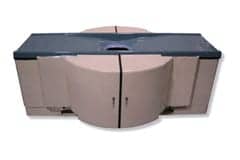 Many of us hear the word cancer and think, “oh no.” But cancer researchers and equipment engineers hear cancer as a battle cry to develop better methods of diagnosis and treatment.
Many of us hear the word cancer and think, “oh no.” But cancer researchers and equipment engineers hear cancer as a battle cry to develop better methods of diagnosis and treatment.
In this month’s special section on Radiation Therapy, we’re looking at medical imaging’s role in treating cancer. As our writers found, advancements in treating four types of cancer — lung, colon, breast and prostate — are taking priority. And for good reason; these are the most deadliest of cancers today.
Lung cancer is the leading cause of cancer death in the U.S., both in men and women, with 180,000 new cases detected annually. People of the ages 45 to 70 are at highest risk. (It is estimated that 90 percent of all lung cancers are caused by smoking.)
Even with early detection, the cure rate for lung cancer is quite discouraging. Only about 13 percent of patients are cured completely.
This is one tough foe. Small cell lung cancers, which make up a quarter of all cases, almost always respond to radiation therapy and chemotherapy, but almost always recur.
Colon cancer is the second-most common non-skin cancer in the U.S. and the second-leading cause of death resulting from cancer. About 138,000 new cases are diagnosed each year, and approximately 55,000 people die of the disease.
Breast cancer strikes women ages 30 to 80, with 80 percent of cancers occurring in women over 50. (About 1 percent of breast cancer cases afflict men each year.)
About 150,000 new cases are diagnosed each year, and approximately 40,000 people die of the disease.
Prostate cancer is the most common non-skin cancer in men. It is found in about half of men over 70 and in almost all men over age 90. It strikes about 69 out of 100,000 men, yet only 3 percent die from it. And it is estimated that 95 percent of all reported cases are found in men between the ages of 45 and 89.
The stories in our special section highlight some of the areas in which imaging is making a difference in cancer treatment — whether it be 3D conformal therapy made possible by 3D CT or MR images, functional nuclear medicine scans that target tumor activity for therapy planning, or intensity modulated radiation therapy for highly personalized treatment.
We know that the mission is to most accurately target the tumor and radiate it, while sparing healthy tissue. Innovations in technology are making this an exact science, with imaging scientists able “to hit a coronary artery on a beating heart in a breathing patient,” says Paul Okunieff, M.D., chairman of radiation oncology at the University of Rochester, in this month’s cover story.
Another example of innovation making great strides in cancer therapy involves the merging of a CT scanner and a linear accelerator. “Cancers that were barely curable before can now be cured,” says James Wong, M.D., chairman of the department of radiation oncology at the Carol G. Simon Cancer Center at Morristown (N.J.) Memorial Hospital. Early data show that five CT/Linac treatments for early stage lung cancer can result in an 80 percent cure rate. Compare that with currently used technology in which 40 treatments yield a 20 percent cure rate.
With examples like these, we know that the cancer battle cry is bringing results and we can rest assured that treatment is getting better every day.
![]()
Mary C. Tierney, Editor
[email protected]



